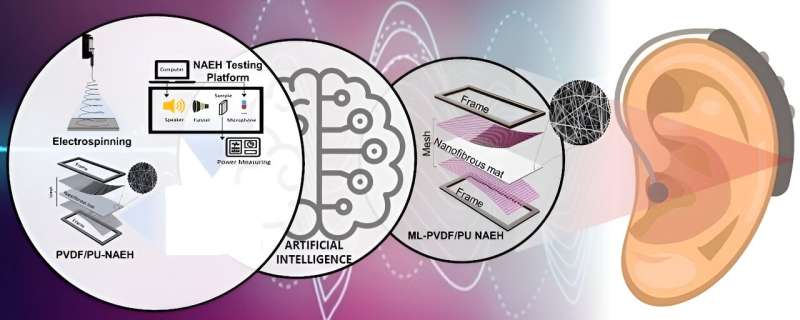This article has been reviewed according to Science X's editorial process and policies. Editors have highlighted the following attributes while ensuring the content's credibility:
fact-checked
peer-reviewed publication
proofread
Enhancing nanofibrous acoustic energy harvesters with AI

Scientists at the Terasaki Institute for Biomedical Innovation (TIBI), have employed artificial intelligence techniques to improve the design and production of nanofibers used in wearable nanofiber acoustic energy harvesters (NAEH). These acoustic devices capture sound energy from the environment and convert it into electrical energy, which can then be applied in useful devices, such as hearing aids.
The study is published in the journal Nano Research.
Many efforts have been made to capture naturally occurring and abundant energy sources from our surrounding environment. Relatively recent advances such as solar panels and wind turbines allow us to efficiently harvest energy from the sun and wind, convert it into electrical energy, and store it for various applications. Similarly, conversions of acoustic energy can be seen in amplifying devices such as microphones, as well as in wearable, flexible electronic devices for personalized health care.
Currently, there has been much interest in using piezoelectric nanogenerators—devices that convert mechanical vibrations, stress, or strain into electrical power—as acoustic energy harvesters. These nanogenerators can convert mechanical energy from sound waves to generate electricity; however, this conversion of sound waves is inefficient, as it occurs mainly in the high frequency sound range, and most environmental sound waves are in the low frequency range. Additionally, choosing optimal materials, structural design, and fabrication parameters make the production of piezoelectric nanogenerators challenging.
As described in their paper, the TIBI scientists' approach to these challenges was two-fold: first, they chose their materials strategically and elected to fabricate nanofibers using polyvinylfluoride (PVDF), which are known for their ability to capture acoustic energy efficiently. When making the nanofiber mixture, polyurethane (PU) was added to the PVDF solution to impart flexibility, and electrospinning (a technique for generating ultrathin fibers) was used to produce the composite PVDF/PU nanofibers.
Secondly, the team applied artificial intelligence (AI) techniques to determine the best fabrication parameters involved in electrospinning the PVDF/polyurethane nanofibers; these parameters included the applied voltage, electrospinning time, and drum rotation speed. Employing these techniques allowed the team to tune the parameter values to obtain maximum power generation from their PVDF/PU nanofibers.
To make their nanoacoustic energy harvester, the TIBI scientists fashioned their PVDF/PU nanofibers into a nanofibrous mat and sandwiched it between aluminum mesh layers that functioned as electrodes. The entire assembly was then encased by two flexible frames.
In tests against conventionally fabricated NAEHs, the resultant AI-generated PVDF/PU NAEHs were found to have better overall performance, yielding a power density level more than 2.5 times higher and a significantly higher energy conversion efficiency (66% vs. 42%).
Furthermore, the AI-generated PVDF/PU NAEHs were able to obtain these results when tested with a wide range of low-frequency sound—well within the levels found in ambient background noise. This allows for excellent sound recognition and the ability to distinguish words with high resolution.
"Models using artificial intelligence optimization, such as the one described here, minimize time spent on trial and error and maximize the effectiveness of the finished product," said Ali Khademhosseini, Ph.D., TIBI's director and CEO. "This can have far-reaching effects on the fabrication of medical devices with significant practicability."
The study's authors include Negar Hosseinzadeh Kouchehbaghi, Maryam Yousefzadeh, Aliakbar Gharehaghaji, Safoora Khosravi, Danial Khorsandi, Reihaneh Haghniaz, Ke Cao, Mehmet R. Dokmeci, Mohammad Rostami, Ali Khademhosseini and Yangzhi Zhu.
More information: Negar Hosseinzadeh Kouchehbaghi et al, A machine learning-guided design and manufacturing of wearable nanofibrous acoustic energy harvesters, Nano Research (2024). DOI: 10.1007/s12274-024-6613-6
Journal information: Nano Research
Provided by Terasaki Institute for Biomedical Innovation





















